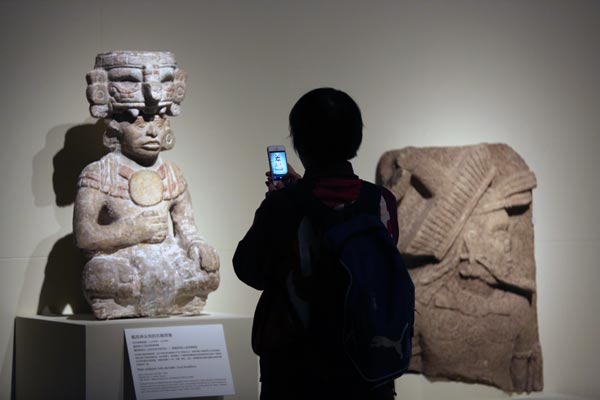 |
|
Mayas: The Language of Beauty exhibition displays 238 cultural relics from Mexico. Jiang Dong / China Daily |
The displays are divided into four sections: the Body as a Canvas (about decoration); the Clothed Body (about attire); the Animal Alter Ego (about the relationship with nature); and the Bodies of the Divine (about worship and beliefs).
They provide a detailed introduction to the civilization that lasted from around the 18th century BC to the 16th century AD. Today's Mexico is still home to 6 million descendants of the Mayas.
"It's interesting to find some similarities in details between Mayan and ancient Chinese civilizations," says exhibition curator Jose Enrique Ortiz Lanz from the National Institute of Anthropology and History of Mexico.
For example, the Mayas adored jade, which was unique in the Americas but was similar to ancient China, he points out.
"Jade masks covered dead bodies of the Mayas. And we see remains of nobles with jade costumes in ancient Chinese tombs."
The displays also reveal the Mayas' worship of social harmony and high respect for the elderly, which coincided with Confucian teachings. One exhibit shows the Mayan moon goddess Ixchel with a rabbit, which may remind the Chinese visitor of Chang'e, the moon goddess in Chinese mythology who is accompanied by a rabbit.
"There are some academic studies in Mexico that look for explanation of possible common or close origins of Mayan and Chinese civilizations, but we need more cooperation in archaeology between the two countries," Ortiz says.
One theory has it that the ancestors of the Mayans migrated to the American continent from East Asia across the Bering Strait.
"But even if we find evidences of common origins, China could be only one of the sources, since the Mayan civilization appears to have been very diverse," he adds. "It's amazing to see different civilizations develop in parallel, with similar elements.
"As long as we endeavor to preserve our respective traditions and try to know each other's better, the world will be more colorful."
|
|
|
|
|
|
